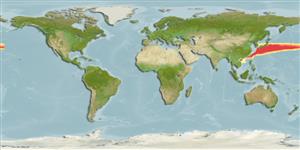Elasmobranquios (tiburones y rayas) (sharks and rays) >
Carcharhiniformes (Ground sharks) >
Pentanchidae (Deepwater catsharks)
Etymology: Apristurus: a-, Latin privative, i.e., without; pristis, from pristes (Gr.), sawyer (but here meaning saw); oura (Gr.), tail, referring to absence of saw-toothed crest of enlarged dermal denticles along upper edge of caudal fin as found in the closely related Pristiurus (=Galeus). (See ETYFish); pinguis: Latin for fat, described as having a “stout” body. (See ETYFish).
Environment: milieu / climate zone / depth range / distribution range
Ecología
marino batipelágico; rango de profundidad 200 - 1000 m (Ref. 41248). Deep-water
Northwest Pacific: East China Sea.
Tamaño / Peso / Age
Maturity: Lm ? range ? - ? cm
Max length : 83.5 cm TL macho / no sexado; (Ref. 101563)
Body stout. Snout length in front of mouth about 1.2 times the distance between nostrils. Long anal fin, rear tip nearly reaching origin of lower caudal lobe. Greater distance between origins of pectoral and pelvic than the distance of tip of snout to origin of pectoral fin; but shorter compared to that from tip of snout to end of pectoral base. Similar to A. japonicus but differs in having distance between orbits about the length of snout in front of mouth; length of nostril about 1/2 distance between nostrils; the upper and lower labials about equal in length (Ref. 41248).
Life cycle and mating behavior
Maturities | Reproducción | Spawnings | Egg(s) | Fecundities | Larva
Oviparous, paired eggs are laid. Embryos feed solely on yolk (Ref. 50449).
Nakaya, K. and K. Sato, 1999. Species grouping within the genus Apristurus (Elasmobranchii: Scyliorhinidae). p. 307-320 In Séret B. & J.-Y. Sire [eds]. Proc. 5th Indo-Pac. Fish Conf., Noumea, 1997. (Ref. 39431)
IUCN Red List Status (Ref. 130435)
Threat to humans
Harmless
Human uses
Herramientas
Special reports
Download XML
Fuentes de Internet
Estimates based on models
Preferred temperature (Ref.
123201): 7.8 - 15, mean 10.1 °C (based on 48 cells).
Phylogenetic diversity index (Ref.
82804): PD
50 = 0.5000 [Uniqueness, from 0.5 = low to 2.0 = high].
Bayesian length-weight: a=0.00288 (0.00171 - 0.00487), b=3.06 (2.91 - 3.21), in cm total length, based on LWR estimates for this species & (Sub)family-body (Ref.
93245).
Nivel trófico (Ref.
69278): 4.0 ±0.4 se; based on size and trophs of closest relatives
Resiliencia (Ref.
120179): Muy bajo, población duplicada en un tiempo mínimo superior a 14 años (Fec assumed to be <10).
Fishing Vulnerability (Ref.
59153): Moderate to high vulnerability (53 of 100).
